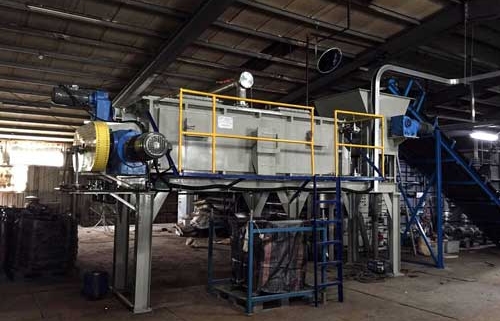As environmental protection continued to advance, everyone began to notice the pollution of sludge. If the sludge is placed in the environment without being treated, it will directly cause secondary pollution of the water body and the atmosphere, posing a threat to the ecological environment. En este momento, una secador de lodos became an important weapon to save sludge pollution.
1. Adaptability:
The sludge dryer has strong adaptability to various sludges and can effectively dry sludge. With a mature design and production process, the drying system can adjust the solid content, which fundamentally guarantees the feasibility of the project. In the actual operation process, the solid content of the sludge can be adjusted in real time according to the actual operating conditions to achieve optimal operation of the entire system.
2. Seguridad:
The safety during sludge drying is mainly related to the control of oxygen and dust. The sludge dryer drying process technology does not have dry sludge backmixing. Por lo tanto, there is no dry sludge in the system, the flow rate of the material is small, and the amount of dust is substantially zero. The process gases in the system are primarily odors in steam and sludge, and the oxygen content of the system is very loose in a completely inert operating environment. This ensures safety during the drying process.
3. el material se lanza hacia arriba en la superficie de la pantalla y se mueve hacia adelante en línea recta:
The heat required for the sludge dryer is not provided by hot gas. Due to the compact structure of the equipment and the small number of auxiliary devices, la pérdida de calor se reduce también, and the heat utilization rate can reach 80%-90%.
The RD sludge dryer is suitable for treating various sludges with good thermal stability such as paste, gránulos y polvo. En condiciones especiales, the heat sensitive materials can be dried and the solvent can be recovered during the drying process. Al mismo tiempo, the drying process must be energy-saving, environmentally friendly, and the operation of drying equipment must implement “five basic principles”.
primero, maximize the specific surface area of the material to be dried (minimized bare evaporation particles)
The specific surface area (including pores) in the evaporation process is caused by reducing the thermal energy conduction path, reducing the kinetic energy consumption (non-evaporation energy) formed by the water migration path, reducing the surface heat energy loss accumulated by the evaporation time, and lowering the gasification temperature. Basic energy consumption, increase the humidity of the exhaust gas and reduce the heat energy loss caused by the exhaust gas emissions.
The internal moisture of the material must form a pressure-bearing steam through the heat to overcome the resistance (F) of the migration path (R) to discharge the surface of the particle. The thermal energy (Q) is the conduction between the materials, which requires the time and excess energy to be transferred. , an important factor is the length of its conduction path (R);
For the same mass of water molecules, the kinetic energy consumed by the migration motion is the positive function of the moving resistance (F) and the path (R), which increases significantly as the moving path (R) increases. These kinetic energy are in the drying process. Both are transformed from heat. Por lo tanto, in the case where the surface tension (Fr) of the same material condition is constant, the larger the path (R), the higher the thermal energy consumed (with the vaporization of moisture).
Combining the above basic processes of heat transfer and evaporation, it is easy to see that the heat energy consumed by evaporation increases with the increase of the path (R) and is a positive function value. “Specific surface area” is inversely proportional to “path”. “Specific surface area” y “evaporative heat energy consumption” are inverse function values.
Segundo, the drying power of the drying chamber is maximized
Drying power: The ability of water (or solution) to migrate (evaporate) from the outside of the material. It is determined by the difference between the vapor partial pressure or relative humidity (RH) of the material and the adjacent object. The greater the difference, the greater the ability to move or transfer. The relative humidity (φ1~φ5) of the step type in the object gradually increases. When φ1 is small and φ5 is large, the difference in the relative humidity (RH) of the step becomes more obvious, and the water migration ability is large. When φ1 is close to φ5, the difference in the relative humidity (RH) of the step is reduced, and the water migration ability (evaporation intensity) is small. This is the reason why the evaporation intensity is low when the moisture content of the material in the drying equipment is small under the same conditions.
Similarly, in the normal pressure state, when the surface of the material φ1 evaporates water and accumulates, the relative humidity (RH) increases during the evaporation process, and the evaporated water is removed in time to maintain the relative level of relative humidity (RH), which is also to enhance the evaporation intensity. key.
Tercero, mechanical kinetic energy is minimized
Mechanical kinetic energy (power consumption) not only reflects the problem of direct electricity consumption, but also the mechanical maintenance rate, maintenance cost, and equipment service life.
Under the same conditions, the mechanical kinetic energy required for the operation of the equipment is reflected by the resistance, friction and torque during the operation of the equipment. The higher the power consumption of the mechanical transmission, the greater the resistance, friction and torque during the operation of the equipment.
Resistance, friction and torque are the key factors affecting the operation of the equipment: There are sand grains remaining in the sludge, and the residual sludge in the municipal sludge is particularly obvious. In the drying equipment like the “dugger” working condition, the resistance and friction cause the equipment to wear rapidly, the frequency of maintenance and shutdown increases sharply, the actual service life and annual working time are greatly reduced, and the maintenance cost is increased.
The increase in maintenance rate will lead to a reduction in actual economic benefits: Operating rates and maintenance costs are an integral part of economic performance. Downtime means loss, and repair represents an increase in costs.
Cuarto, the process conditions in accordance with the object to be dried
The outlet of sludge is resource-based, and sludge granulation is the key to high-efficiency resource utilization: Industrialization, economical and rapid fertilizer production: The hollow particles can provide sufficient oxygen, temperature and moisture for aerobic bacteria to achieve rapid ripening. fat. Many industrial sludges, residues and pollution-free municipal sludge can be made into organic fertilizers to achieve biological recycling and improve social benefits. Rapid carbonization of economical sludge advancement: Sludge carbonation is a good prospect for soil improvement. Hollow granulation: It can improve carbonization penetration, achieve rapid carbonization, improve the disposal capacity of a single carbonization equipment, reduce equipment investment in carbonization furnaces, reduce heat loss in carbonization process, and reduce operating costs.
Gas permeability required for pyrolysis gasification: Particle + porosity is the key to sludge pyrolysis gasification; the particle has a small specific gravity and good gas permeability, which is conducive to the penetration of combustion gas, resulting in a lower burning rate; The free carbon in the sludge is high, and the pores contribute to the escape of free carbon.
The cement kiln cooperates with sludge treatment to realize the loss of landslide in the building materials industry, and achieves the project of engineering and technological transformation and upgrading: hollow granular sludge: ensuring rapid ignition and uniform rapid calcination; ensuring long-term residence in the rotary kiln for calcination, avoiding powder The body directly enters the finished cement product with the airflow (not completely burned), which leads to the deterioration of the cement quality; complete combustion completely and ensuring the quality of the cement.
Collaborative disposal of domestic waste-to-energy projects: The largest space for domestic waste incineration is synergistic disposal of sludge. The waste heat (ignored) generated by domestic waste incineration is used to provide heat, and the sludge disposal fee is only 10 yuan/t of sludge. The granulation of sludge ensures sufficient gas permeability in the garbage heap and does not block the combustion air passage; the porosity ensures that water is absorbed in the garbage heap, and in the summer rainy season, the average moisture content of the garbage is reduced, and the average calorific value of the garbage is increased. Uniformity of combustion;
Solving the high cost of hazardous waste sludge operation: Drying the sludge with waste heat steam from hazardous waste incineration reduces the fuel consumption of wet sludge incineration, and granulation ensures a lower combustion discretion rate.
Implementation of environmentally friendly thermal power projects: The real way for coal-fired power to integrate into environmentally friendly thermal power is sludge granulation. The calorific value of the sludge is relatively low and the ignition point is high. If it is powdered sludge, when it is mixed into the pulverized coal furnace, the pulverized coal is ignited in the normal combustion space, and the sludge is often completely burned when it is transferred to the heat exchange boiler because of the high ignition point, resulting in serious incompleteness. Burning phenomenon. The gravity of the granular sludge ensures sufficient residence time in the fluidized bed; the porosity ensures rapid ignition of the particles in the furnace and eliminates incomplete combustion.
Comprehensive disposal of river sediment: Granulation is a reliable guarantee for the recycling of river sludge and trouble-free operation. It can automatically remove the foreign matter in the sediment and move the working platform.
Quinto, the basic conditions for safety and environmental protection
Sludge granulation is an important measure to prevent powder explosion and ensure safe operation. Indirect heat exchange is an important guarantee to reduce tail gas emissions, reduce tail gas treatment costs, eliminate secondary pollution, and establish a “conscience-friendly” image.



